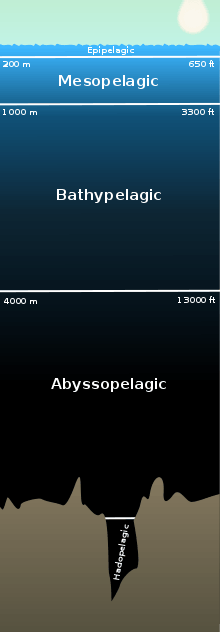Mesopelagic zone
| Aquatic layers |
|---|
| Stratification |
| See also |

The mesopelagic (Greek μέσον, middle) (also known as the middle pelagic or twilight zone) is that part of the pelagic zone that extends from a depth of 200 to 1000 meters (~660 to 3300 feet)[1] below the ocean surface. It lies between the photic epipelagic above and the aphotic bathypelagic below, where there is no light at all.
Physical conditions
Although the temperature varies less at any one height than the epipelagic, the mesopelagic is the location of the thermocline, and in warmer regions of the world, the temperature varies from over 20 °C (68 °F) at the top to around 4 °C (39 °F) at the boundary with the bathyal zone. Water generally moves slowly in the mesopelagic with a residency time of about a century,[2] though a variety of animals move vertically through the zone on a daily basis and various debris sink down in relatively short time frames.
The region was initially discovered by American researchers during World War II in 1942 during anti-submarine research with sonar. Sonar at the time could not penetrate below this depth due to the large number of creatures obstructing sound waves.[3]
Ecology
Although some light penetrates the mesopelagic zone, it is insufficient for photosynthesis. The general types of life forms found are daytime visiting herbivores, detritivores feeding on dead organisms and fecal pellets, and carnivores feeding on the former types.[2] Algae do not reside inside the mesopelagic layer, due to lack of light.[3]
Examples of animals in the mesopelagic zone are bristlemouth, swordfish, squid, wolf eels, cuttlefish and other semi-deepsea creatures. The bristlemouth is the Earth's most abundant vertebrate, numbering in the hundreds of trillions to quadrillions.[4] The small amount of sunlight is sufficient for animals, such as the chain catshark, to be fluorescent.
A 2015 study found that the zone's biomass is up to 10 times greater than earlier estimates, totaling 10 billion tons and representing some 90 percent of the planet’s fish biomass, some 100 times that of the annual seafood catch and 200 times that of the world’s 24 billion chickens.[5] Commercial fisherman have found the biomass viable for fish farming meal, oil and silage.[5] In 2002, the UN Food and Agriculture Organization discussed in a report that the mesopelagic zone has biomass viable for fish-meal and fish-oil industry.[3]
Climate change
The quantity of mesopelagic life is large enough to play a significant role in global carbon cycling. As the fish participate in the food chain, they acquire carbon rendered from carbon dioxide absorbed by surface waters. Upon death, they transport that carbon into the sea bottom or back upon coastal shores. As of 2015 the revised estimates of mesopelagic life had yet to be incorporated into climate models. Per year, it is estimated to cycle between 5 billion and 12 billion tonnes of CO2 from the atmosphere through the ocean region.[3]
References
- ↑ Trujillo, Alan P.; Thurman, Harold V. (2010). Essentials of Oceanography (10th ed.). Prentice Hall. pp. 363–366.
- 1 2 Hogan, Michael C. "Mesopelagic zone". The Encyclopedia or Earth. Retrieved 17 September 2013.
- 1 2 3 4 "The mesopelagic: Cinderella of the oceans". The Economist. Retrieved 2017-04-23.
- ↑ Broad, William J. (June 29, 2015). "An Ocean Mystery in the Trillions". The New York Times. Retrieved August 2015. Check date values in:
|accessdate=(help) - 1 2 BROAD, WILLIAM J. (June 29, 2015). "Dark Region of Ocean May Shed Light on Climate Change and Other Issues". New York Times. Retrieved 2017-04-23.

